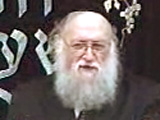Beit Midrash
- Sections
- Chemdat Yamim
- Bemare Habazak - Rabbis Questions
Answer: The gemara (Rosh Hashana 33b) says that the length of the tekia is like that of a [set of] teruah. It does not say that one is longer than the other, and it is impossible for them to be exactly the same. Apparently, the teruah is used as an objective point of reference for the tekia – it must be at least as long as a normal set of teruah. This may be one of the reasons that all opinions found in the Tur/Beit Yosef/Shulchan Aruch and classical commentaries assume that it does not matter which is longer in a given series. We will bring a few of many possible proofs.
Poskim use an individual teruah short blast (tarmut) as a unit to describe the various blasts. For example, there is a machloket whether each shever must be at least 3 tarmutin long or less than 3 (see Shulchan Aruch, Orach Chayim 590:3). We assume that a tekia in a teruah series is 9 tarmutin long and in a shevarim-teruah it is 18 or so, each corresponding to the middle part (see Mishna Berura 590:14). No one says that these numbers are irrelevant if the middle part is the slightest bit over average.
A major timing concern is that doing a longer than necessary shever that reaches the minimum length of a tekia would preclude its being a shever. The poskim say that according to the opinion that a teruah set contains 9 blasts (there is an opinion of only 3), the length of a tekia is at least 9 tarmutin, and therefore an individual shever could be up to (but not including) 9 tarmutin (see Mishna Berura 590:13). In theory, in a shevarim-teruah series, where the tekia is at least 18, each shever can be up to 18. But if one did that and posits that the middle cannot exceed the tekia, the tekia would end up being upwards of 60 tarmutin, a length found only by a tekia gedola.
Regarding the debate whether it is proper to do more than 3 shevarim blasts in a set, the Perisha says we avoid doing that because in a shevarim-teruah one might run out of steam before getting to the 9 subsequent teruot. In contrast, he says, we do not care about extra teruot (see also Shulchan Aruch, ibid.), as he can stop when he is tired. He is unbothered that a long teruah following a shevarim could cause the middle to exceed the previous or subsequent tekia. The reason, again, is that the minimum length of the tekia depends on the length requirement of the middle section and is unaffected by unnecessarily long teruot.
At least one contemporary posek, the Moadim U’zemanim (I:5), mentions a "practice of the stringent" to have the tekiot be as long as the middle section in practice. He concedes that this opinion is not found in the poskim and identifies one Rishon (not cited by the Beit Yosef) and one Acharon (the S’fat Emet to Rosh Hashana 33b, not in a psak context) who share this opinion.
I do not oppose unnecessary chumrot to fulfill fringe opinions regarding this important mitzva. The problem is that in your case, the tiny gain causes greater problems than it is worth. As one who has served in both capacities, I believe that a ba’al tokeia is much more accurate at counting teruah blasts than a makree. If the makree tries to stop the ba’al tokeia after 9-10 blows before the latter planned, it is very possible he will stop him before 9, which would very likely disqualify the set (see Mishna Berura 590:15). The Moadim U’zemanim’s stringency assumes the minhag to do longer teruot than necessary and instructs lengthening the tekiot. He does not suggest being stingy with the teruot, certainly not to the point that a slight miscounting would cause them to be fewer than 9.
While a ba’al tokeia should follow his makree’s stringencies, at least if he is the rabbi, here we suggest you show the makree the evidence we have presented. If his opinion is unchanged, you should follow whatever the rabbi says.

Bemare Habazak - Rabbis Questions (627)
Various Rabbis
149 - Tallit and Tefillin During Selichot
150 - Shortening Blowing of Teruah to Conform to Tekia
151 - Havadala on Yom Kippur Which Falls on Shabbat
Load More

Ask the Rabbi: Finishing to Eat but Continuing to Drink
Rabbi Daniel Mann | Iyar 5785

Ask the Rabbi: Forgot to Remove Tefillin Before Musaf of Rosh Chodesh
Rabbi Daniel Mann | Kislev 5786

Ask the Rabbi: Mincha after Sunset
Rabbi Daniel Mann | Cheshvan 5786

Ask the Rabbi: Minyan or Tallit and Tefillin?
Rabbi Daniel Mann | Tammuz 5785

Rabbi Daniel Mann

Reciting Kri’at Shema at the Very End of its Time
Sivan 21 5779

Making Sure your Check Is Cashed
Kislev 5783

Timtum Halev – Part II
Adar I 8 5776
























